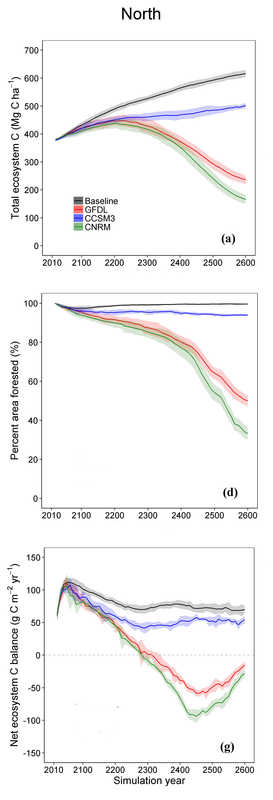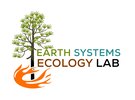 The carbon carrying capacity of an ecosystem is the maximum amount of carbon that can be sustained in a given location on the planet under prevailing climate and natural disturbance conditions. The idea is that given the temperature range and amount of precipitation at a given location, there are only certain types of plant species that can grow there. This is exactly why we don’t see giant sequoia trees growing next to Joshua trees in the Mojave desert. rests in the Sierra are heavily dependent on the winter snowpack for providing growing season moisture. Under a moderate-high emission scenario, the snowline elevation is projected to increase by about 200 meters (650 feet) of elevation over the next 100 years. Now, as any geographer will tell you when you go up in elevation there is less land area. This increasing snowline elevation means there will be considerably less area that maintains a snowpack to provide water during the growing season. In a recent paper led by Shuang Liang, we ran simulations of forests of the Sierra Nevada under projected climate change and wildfire. We used climate projects from three climate models and area burned projections from Leroy Westerling. We ran our simulations out over several hundred years and assumed that the climate beyond the year 2100 would be similar to the climate projected for 2090-2100. These long simulation times allowed us to evaluate the effects of altered climate on the carbon carrying capacity of currently forested areas in the Sierra Nevada. Our simulations show that with increased warming and drying and more area burned by wildfire that the amount of carbon these ecosystems can sustain will decrease by as much as 73% (top panel). A big part of that reduction is due to as much as a 65% reduction in forested area (middle panel). The loss of forest cover is driven by fewer species of tree seedlings being able to establish in these future conditions, especially after more area is burned by wildfire. As the figure shows, there is quite a bit of variability between the different climate model projections. The GFDL (red) and CNRM (green) models show a large decline in both carbon and forested area, whereas the CCSM3 (blue) climate model shows both carbon and forested area holding pretty steady. The loss of forest cover leads to the carbon flux results in the bottom panel. The bottom panel shows the net ecosystem carbon balance. When the values are positive, the forests are removing carbon from the atmosphere and when the values are negative, the forests are a source of carbon to the atmosphere. Under two of the climate model projections, Sierran forests become sources of carbon to the atmosphere and will be another thing we have to consider when thinking about mitigating climate change. The big question is – what can we do about the prospect of having 50% of the forested area converting to something other than forest? Reducing our greenhouse gas emissions to the atmosphere is the logical place to start, but since this blog is about forest ecology research you will have to stay tuned for the results of our current work that is looking at the role of management in reducing the risk of forest cover loss to climate change and wildfire.
0 Comments
Your comment will be posted after it is approved.
Leave a Reply. |
Details
Archives
October 2023
Categories
All
|

 RSS Feed
RSS Feed